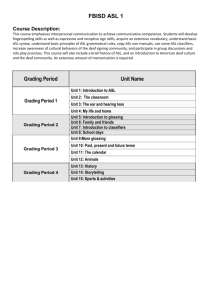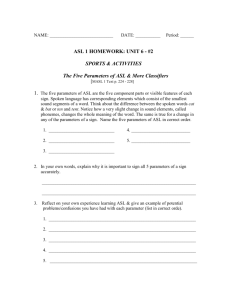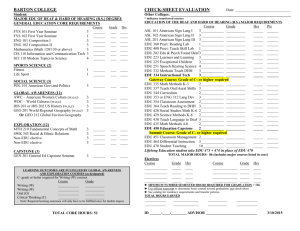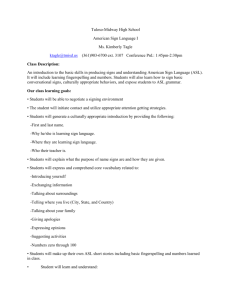Abstract
advertisement
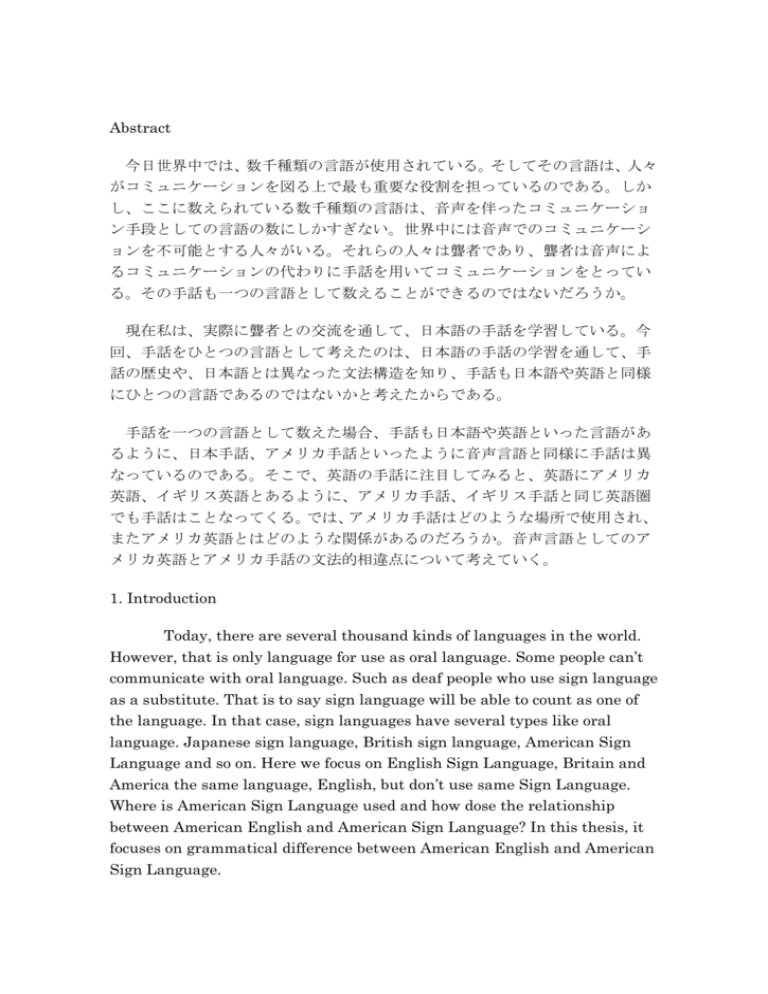
Abstract 今日世界中では、数千種類の言語が使用されている。そしてその言語は、人々 がコミュニケーションを図る上で最も重要な役割を担っているのである。しか し、ここに数えられている数千種類の言語は、音声を伴ったコミュニケーショ ン手段としての言語の数にしかすぎない。世界中には音声でのコミュニケーシ ョンを不可能とする人々がいる。それらの人々は聾者であり、聾者は音声によ るコミュニケーションの代わりに手話を用いてコミュニケーションをとってい る。その手話も一つの言語として数えることができるのではないだろうか。 現在私は、実際に聾者との交流を通して、日本語の手話を学習している。今 回、手話をひとつの言語として考えたのは、日本語の手話の学習を通して、手 話の歴史や、日本語とは異なった文法構造を知り、手話も日本語や英語と同様 にひとつの言語であるのではないかと考えたからである。 手話を一つの言語として数えた場合、手話も日本語や英語といった言語があ るように、日本手話、アメリカ手話といったように音声言語と同様に手話は異 なっているのである。そこで、英語の手話に注目してみると、英語にアメリカ 英語、イギリス英語とあるように、アメリカ手話、イギリス手話と同じ英語圏 でも手話はことなってくる。では、アメリカ手話はどのような場所で使用され、 またアメリカ英語とはどのような関係があるのだろうか。音声言語としてのア メリカ英語とアメリカ手話の文法的相違点について考えていく。 1. Introduction Today, there are several thousand kinds of languages in the world. However, that is only language for use as oral language. Some people can’t communicate with oral language. Such as deaf people who use sign language as a substitute. That is to say sign language will be able to count as one of the language. In that case, sign languages have several types like oral language. Japanese sign language, British sign language, American Sign Language and so on. Here we focus on English Sign Language, Britain and America the same language, English, but don’t use same Sign Language. Where is American Sign Language used and how dose the relationship between American English and American Sign Language? In this thesis, it focuses on grammatical difference between American English and American Sign Language. AMERICAN ENGLISH AND AMERICAN SIGN LANGUAGE (SATOKO OBA) 2. What is ASL ? In this section will review Sign Language and American Sign Language. Sign Language is general term, which means the use of hands gestures. Then American Sign Language is included in sign language. Each sign language has its own characteristic and background. That is to say sign languages are independent languages. It is used by many people, in many places. This section, explain about their character, background and so on. 2.1 SL (Sign Language) According to Wikipedia, “A sign language is a language which uses gestures instead to convey meaning combining hand shapes, orientation and movement of the hands, arms or body, facial expression and lip-patterns.” Sign languages are usually developed in deaf communities, which include interpreters and friends and families of deaf people as well as people who are deaf or hearing impaired themselves. In general, sign language is not international. Wherever communities of deaf people exist, Sign Language develops. As with oral languages, these vary from region to region. They are not based on the oral language in the country origin. Hundreds of Sign Languages are in use not only by deaf people but also around the world. That is to say, Sign Languages have also arisen in hearing community. For example, American Indians of Great Plains region used a Sign Language to communicate among tribes who used different phonetic language, and there are a few users still alive today. Other simple forms of signed communication have been developed in situations where speech is not practical, such as between scuba divers, in television recording studios, in loud workplaces (like a bidding Japanese market). On the whole sign languages are independent of oral language and they follow their own developmental principle. For example, American Sign Language and British Sign Language are different and they can’t mutually understood, even though the hearing people of America and Britain can AMERICAN ENGLISH AND AMERICAN SIGN LANGUAGE (SATOKO OBA) understand each other phonetic language. That is to say they share the same oral language: English. 2.2 ASL (American Sign Language) According to Wikipedia, “American Sign Language is the dominant sign language in the United States, Canada and parts of Mexico. American Sign Language is usually abbreviated ASL though it has also been known as Ameslan.” Sign Language began among deaf children spending time with their friends. It was reported from child to child, and change over the generations. But the propoltion of deaf children is at most one thousandths of the general popuration. It was natural for children to live separate from other deaf children. In the middle of the18th century, schools were built that started to the educate deaf children togather. Deaf children got to spend time with their friends for the first time. The first school for deaf people was built in Paris, France. So, French Sign Language has the longest history. That history is about 250 years long. After that, a school for the deaf people was built in every country in the world, and many sign languagewere made. Martha’s Vineyard is an island with a very high proportion of deaf children. In the 19th century, a school for the deaf people was built in Martha’s Vineyard. Many island children entered that school, so the origin of today’s American Sign Language is from Martha’s Vineyard island’s Sign Lnguage. In America, 21 million to 28 million people (about ten perscnt of the population) have light (25 decibel) or tertiary (90 decibel) defective hearing. More than 90 decibel deaf people are from about 1 million to 1.5 million. As with other Sign Languages, the grammar and syntax are separate and distinct from the spoken language spoken in its area of influence. In the nexe section will review ASL grammar. 3 Grammar of American English and ASL AMERICAN ENGLISH AND AMERICAN SIGN LANGUAGE (SATOKO OBA) Here is an explanation of the grammar of American English and American Sign Language. Grammar is a set of rules for using language. Theses rules guide users in the correct speaking or signing of a language. As has been mentioned, both American English and American Sign Language have their own characteristics. Of course, those grammars are different. However, modern ASL words are based on English words. Language is always changing, especially spoken languages are changing. So ASL sign is change with changes in American English. For that reason, there are close relationship between American English and ASL. On the other hand, there are big differences between the two. American English doesn’t like to repeat words, especially subjects and nouns. So nouns are changed into pronoun. However, ASL repears of words, especially subjects and nouns. Also, ASL uses finger spelling when explaining nouns. In this section, I will first explain American English’s grammar, and then explain ASL grammar, and rules of ASL. 3.1 Grammar of American English Basic English grammar has “the five cardinal sentences”. The first cardinal sentence is SV such as “Birds sing”. The second cardinal sentence is SVC such as “Thomas is a baby”. The third cardinal sentence is SVO such as “I bought a car”. The fourth cardinal sentence is SVOO such as “My father gave me a pen”. The fifth cardinal sentence is SVOC such as “Ken made his son a doctor”. As an exception to those rules, “There is a book on the desk” and “It is a good idea to cancel the class”. When English user use English, they choose between these five types of sentence. However an English user doesn’t always use perfect grammar when we speak English, especially where tense is concerned. When we talk abut friends or other person past things, we use present tense. As these words, there are “come” “go” “say” and so on. Also when we talk about future things, we use present tense. Also English user can use direct speech and indirect speech in spoken language. AMERICAN ENGLISH AND AMERICAN SIGN LANGUAGE (SATOKO OBA) Perfect intransitive SV Imperfect intransitive SVC Intransitive Verb SVO Perfect transitive Transitive SVOO imperfect transitive SVOC Figure1: The five cardinal sentences pattern in English 3.2 Grammar of ASL American Sign Language has its own grammar system, separate from that of English. This means that ASL grammar has its rules for phonology, morphology, syntax, and pragmatics. In general, ASL sentence follow a “topic” “comment” arrangement. Another name for a “comment” is the term “predicate”. A predicate is simply a word or phrase that says something about a topic. In general the subject of the sentence is the topic. The predicate is the comments. When discussing past and future events the sentence tend to establish a time- frame before the rest of the sentence. That structure is “time” “topic” “comment”. For example: “WEEK-PAST Pro1 WASH MY CAR” (The “Pro1” term means to use a first-person pronoun. A first-person pronoun means “I or me”. So “Pro1” is just a fancy way of saying “I” or “me”. In the above example one would simply point at oneself to mean “Pro1”. ) Quite often ASL, signers will use the object of their sentence as the topic. For example: “MY CAR, I WASH WEEK-PAST” Using the object in sentence as the topic of the sentence is called “topicalization”. In this example “my car” becomes the subject, instead of “me”. The fact that “I washed it last week” becomes the comment. AMERICAN ENGLISH AND AMERICAN SIGN LANGUAGE (SATOKO OBA) There is more than one sign for “WASH”. Washing a car or a window is different from the generic sign for “WASH” to wash-in-a-machine, or to wash a dish. 3.2.1 Repetition of words The first characteristic of ASL is the repetition of words. When hearing people communicate with other people using speech, the use voice, ears, and eyes are used. However when deaf people communicate with other people, they use the hands, eyes and mouth. Deaf people can’t use voice or ears. That is to say, the information channels of deaf people are fewer than hearing people. To supplement those, deaf people repeat important information. Another reason, for repetition of words is just in case the listener (receiver) missed who the signer was talking about. Even if hearing people withdraw their gaze, they can still understand what the speakers were taking about. But, if deaf people withdraw their gaze, they miss important information. So they repeat important words, just in case they withdraw them gaze. In many informal situations, people get lazy and the repeat is left off unless it’s necessary. It’s the same way in English when someone uses slang or omits unnecessary words. 3.2.2 Use of finger spelling Finger spelling describes each alphabet letter using move more and shape of fingers. Though deaf people communicate with sign language, finger spelling is useful when they talk about names, places, new words and other things. It is also use when they don’t know how to describe a word using sing language. According to a Japanese deaf person (Mr. Naito), finger spelling is very important, because deaf people can’t hear any sounds or pronunciation. They don’t get much information from society, and they don’t know as many words as people who can hear. To help that problem, they use finger spelling. And then they can get new information and they can learn new names of AMERICAN ENGLISH AND AMERICAN SIGN LANGUAGE (SATOKO OBA) things. Therefore finger spelling is very important medium in Sign Language. (1) English-Hi. My name is Tommy. ASL- Hi my name T-O-M-M-Y. (2)English-I have a dog named Lucky. ASL- Me have dog (point) name L-U-C-K-Y. The reason for the pointing is to indicate where the dog is. Generally, this is to the left on a right-hand signer, and this is kept throughout the entire conversation. When signing with someone else, the other speaker keeps the location as well, pointing to the same place you did. (3) English- He is a big dog. ASL- He (point) big (fs long sign) dog Finger Spelling long sign means that a finger spelled word has become a sign, and signed very quickly. This is because a conceptually correct sentence could not use the normal sign for “big”. (4) English- He likes his doghouse in the backyard. ASL- He (point) like dog house there b-a-c-k-y-a-r-d. (5) English- He sits in until I call him. ASL- He (point) sit until happen me call- out L-U-C-K-Y. In this case, sit would be a vertical circular motion, indicating that the dog waiting for a period of time. Also, don’t confuse the word call-out with the sign for telephone. The sign shout and call-out is the same sign. Finger spelling has one sign to one sentence, which means one hand shape has one sentence meaning. The most famous hand shape is “I love you.” It turns the hollow of a hand to receiver. Then crook one middle finger and ring finger. This hand shape means “I love you”. It’s just like a gesture. Though it is not finger spelling, ASL has contractions just like English. In English it would use I’m, or aren’t, but ASL uses them in the AMERICAN ENGLISH AND AMERICAN SIGN LANGUAGE (SATOKO OBA) form of a full sentence in one sign. For example, “Do-do”. Its means “What to do?” or “Why are you doing it?” in American English. Of course, because this is ASL, those are definitely not it’s only two uses. For example, (1)English- What are you doing Friday night? ASL- Do-do you Friday night or Friday night do-do you? (2) English- What do we do everyday? ASL-Everyday, two-of-us do-do. The sign “for-for” has similar intentions. “For-for” means “What for?” or “Why?” in American English. It can be use for emphasis on a matter, instead of just the one sign for “why”. 3.2.3 Use of tenses and number Times and dates are a very interesting subject in ASL for two reasons: 1. There are many ways to sign different times and 2. Their specific place in a sentence can be a problem. Numbers of ASL is used in many ways. With time numbers, the general rule is to tap the wrist (the sign for time) and come right after with the number. For example English- The meeting is at 2:00. ASL- Meeting time 2. With time there is a “9 rule”, meaning that number 1 through 9 are generally made part of the first sign. If one was to sign “The meeting is at 2:00”, then two would be incorporated into the tap on the wrist, Time 2:00 would become 1 sign, in other words. Days are made similarly, and the “9 rule” is applied to the sign for “day”. This is also true with weeks and minutes, are not incorporated for years but the use with years are different, numbers into the sign, unless it is for a future or past tense context. The number is signed first, then, years are signed. If one is signing “next year” or “last year” (1 year ago or in the future) the “1” is signed after one sign “year”. The 1 also indicates future or past tense, meaning that if it’s one year in the future the 1 is signed out towards space, and if it’s one year ago the 1 is signed towards the back. AMERICAN ENGLISH AND AMERICAN SIGN LANGUAGE (SATOKO OBA) The sentence is strange: something like “The sign for ‘three of us’ is another interesting case”. On the hand, numbers 2 though 5 are used, turned palm up, and circled counterclockwise in horizontal manner indicate 2 through 5 people. Although,” two-of –us” is not really horizontal. An example of using one of these contractions would be: English- Yesterday, Jack, Susie, and I went to Tokyo. ASL- Yesterday, three-of-us go-there Tokyo. 3.2.4 Other Another thing, in ASL wh-question is last in the sentence. Especially “why” is interesting. In English, we use conjunctions like “because” to connect certain sentence, like: “We went to the store because we were out of hood.” But in ASL, those types of sentence become a rhetorical question, or are put into a question/answer form. “Two-of-us go there store why? have food none.” Mostly they are used to focus the reader’s attention on additional information to be given. Do not assume, though, that the word “because” is not used in ASL. Not all sentence want to draw the attention, and “because” is used. (1) English-I got Lucky for my birthday two years ago. ASL-Two year past, me receive L-U-C-K-Y why? birthday. (2) English- I love Lucky very much, because he is the best dog in whole world. ASL-Me love L-U-C-K-Y why? he (point) best dog all world. With love, it would be held for a little while to show that you really love the dog. Also, all world would have be inclusive of the enter world. One possibility is to sign open hand, palm down, full counter-clockwise horizontal circle, then world, instead of signing all. 4 Conclusions There are big differences between American English and American Sign Language. American English doesn’t like to repeat words, especially AMERICAN ENGLISH AND AMERICAN SIGN LANGUAGE (SATOKO OBA) subject and noun, so it changes into pronoun. On the other hand, in ASL is repetition of words, especially subject and noun. Also ASL uses finger spelling when they explain about names of things. Of course the origins of the two langeare are different too. Both American English users and American Sign Language users, they use the same written language. However spoken the language is different. However, the most important thing is to deliver the massage to other people. So we need to use facial expressions and heart when we talk with ASL. Of course, we need these noting with ASL, but also with Sign Languages, American English and other phonetic language. Bibliography “A short History of ASL” available http://www.geocities.com/Heartland/Ridge/9672/HistoryASL.html 2004. of June Butterworth, Rod R. and Flodin, Mickey. “History of Sign Language” in "The Perigee Visual Dictionary of Signing" published by The Berkley Publishing Group, 1995 available http://www2.uic.edu/stud_orgs/cultures/daa/ASLHistory.html of June 2004. “History of Sign Language” in Resources American Sign Language History online available http://www.westislandlife.com/asl/history.htm of June 2004 J.G. Kyle and B. Woll “Sign Language –The study of deaf people and their language” published by Cambridge University Press Martin L.A., Sternberg Ed. D. 1990 “American Sign Language Concise Dictionary” published by Perennial Library. Nakamura, Karen “About American Sign Language” in Deaf Resource Library online, March 02, available http://www.dealibrary.org/asl.html June 2004. of Schneider, Elaine Ernst “American Sign Language (ASL) vs. Signed English AMERICAN ENGLISH AND AMERICAN SIGN LANGUAGE (SATOKO OBA) (SE)” in Lesson Tutor online, April 01 available http://www.lessontutor.com/eesASLIntro.html of June 2004. Schneider, Elaine Ernst “American Sign Language for the Deaf Lesson 5, "I can..." in Lesson Tutor online, September 03 available http://www.lessontutor.com/eesASL5.html of June 2004. Wikipedia “American Sign Language” available http://en.wikipedia.org/wiki/America_Sign_Language of June 2004. Wikipedia “Sign Language” available http://en.wikipedia.org/wiki/sing_language of June 2004. Wilcox, Sherman “American Sign Language as a Foreign Language” online available http://www.westislandlife.com/asl/history.html of June 2004 AMERICAN ENGLISH AND AMERICAN SIGN LANGUAGE (SATOKO OBA)

